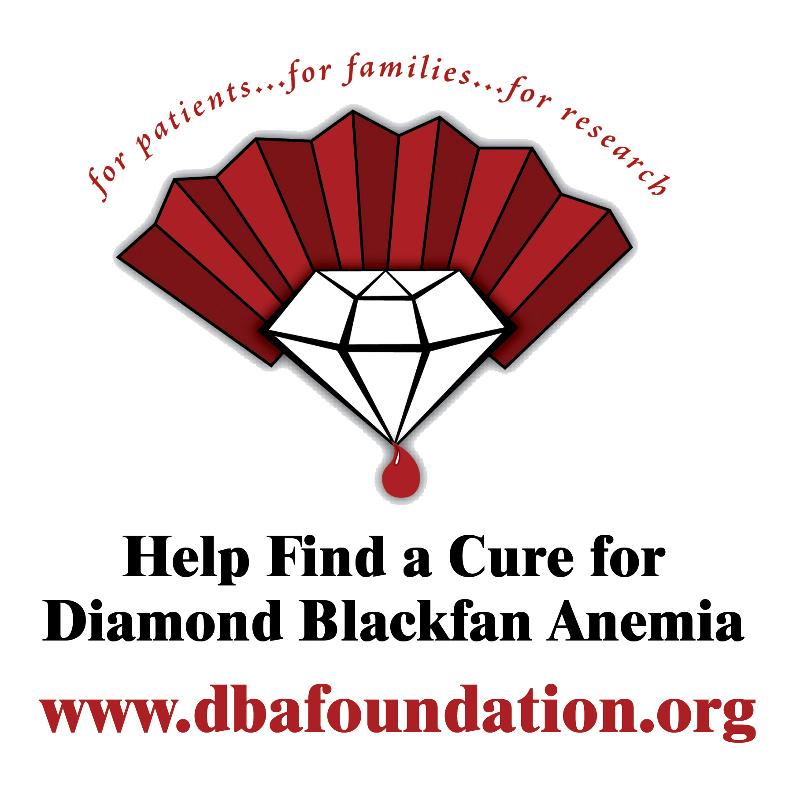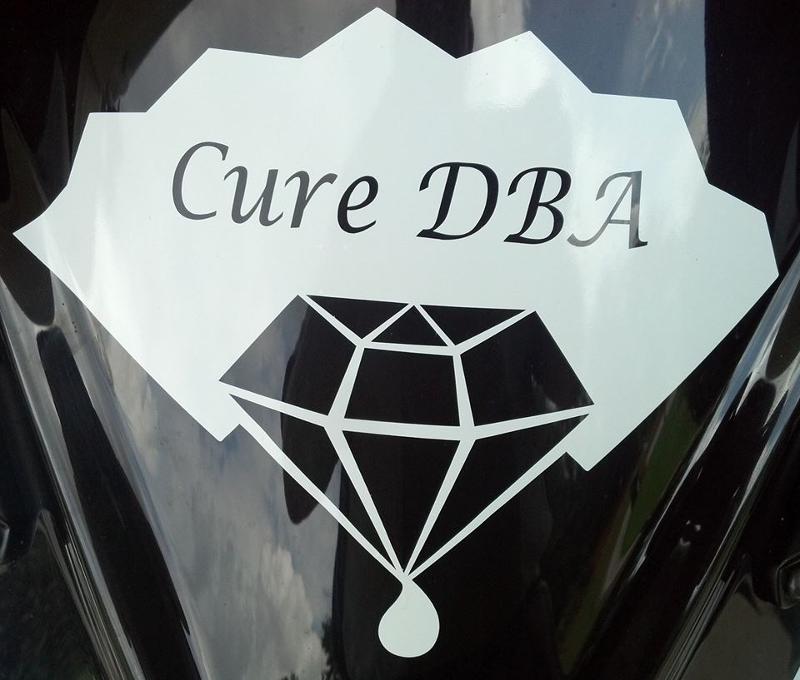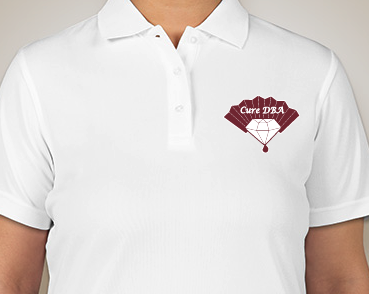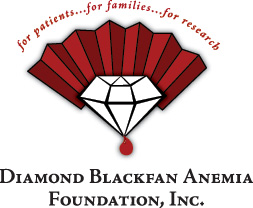Help us Make a Difference!
Celebrate DBA Moms & Dads
|
The Diamond Blackfan Anemia Foundation is proud to continue to provide support for DBA patients, families, and research. We simply can not do what we do without the support of our DBA families and friends. It's easy to see your donations at work. Our website is continuously updated and keeping you informed about the research we fund is a top priority. You can see how much we have accomplished HERE.
The Diamond Blackfan Anemia Foundation (DBAF) is celebrating DBA moms and dads and we need your help! Beginning on Mother's Day (May 10, 2015) and running through Father's Day (June 20, 2015), our goal is to raise $25,000 in honor of our dedicated DBA moms and dads.
So, if you are a DBA mom or dad, if you love (or even like!) a DBA mom or dad, if you are or have/had a mom or dad, grandmother or grandfather, if you are still reading this... PLEASE DONATE and help celebrate our very special families! This campaign was successful in 2014 and we need your help to make it happen again! Please help us raise $25,000 in 42 days!
Every dollar brings us one dollar closer to better treatment options and a cure. Your donation will help fund critical research for a disorder that has touched all our lives. Please show your support for DBA families and the DBAF's Mission.
In recent years, the scientific community has made many advances in understanding DBA on both the genetic and molecular levels. Discoveries have, and will continue to, aid in the diagnosis, treatment, and clinical care of DBA patients. We are proud that the DBAF has been able to contribute to these accomplishments. Breakthroughs made in DBA research will unquestionably lead to significant progress in understanding blood cell production, birth defects, and cancer. These important implications have brought global attention to this rare disorder.
We need your help to keep progress moving towards a cure. Donating is easy and your contribution is tax deductible to the full extent allowed by law. Please visit our online fundraising page for information on the many ways to donate.
To add your name to our list of supporters celebrating DBA moms and dads, please CLICK HERE.
Please get involved and help make this happen! Share this email with your friends. Post the link to the online fundraising page and ask your Facebook friends to help fund important research. Help spread the word.
As always, THANK YOU for your support!
|
| |
Ongoing Fundraisers
|
Family Letter Writing Campaign
Pre-printed letters and envelopes have been created for you to send to your contacts! Call or email for more information.
Contact:
Dawn Baumgardner
dbaumgardner@dbafoundation.org
716.674.2818
Wristbands Available
Contact:
Twila Edwards
twilak@cox.net
Tribute Cards Available
(2 Styles)
In honor of...
In memory of...
Contact:
Dawn Baumgardner
dbaumgardner@dbafoundation.org
716.674.2818
5" x 5" Stickers Available
Contact:
Dawn Baumgardner
dbaumgardner@dbafoundation.org
716.674.2818

7" x 5" Decals Available
Contact:
David Voltz
dcvol@yahoo.com

AmazonSmile Program
You Shop... Amazon Gives!
If you shop on Amazon, please log in using smile.amazon.com, select Diamond Blackfan Anemia Foundation as your charity, and shop as usual. Amazon will donate .05% of your purchase to the DBAF.
Good Search/Good Shop
Raise money for DBAF
just by searching the web and shopping online!
|
|
|
| The Diamond Blackfan Anemia Foundation (DBAF) is committed to keeping you updated and connected to the entire DBA community. The DBA Foundation is YOUR Foundation! We encourage you to share your ideas, photos, and stories for our website and upcoming newsletters. Contact us at DBAFoundation@juno.com. |
|
Exciting News!
some very exciting news that we are pleased to share with you. Please keep in mind, these findings and continuing developments are still in the research stage in a laboratory. Clinical trials are needed to test the safety and efficacy in humans.
The Whitehead Institute published this press release explaining the progress and findings of Dr. Lodish's lab, Repurposed Anti-cholesterol Drug Could Improve Treatment-Resistant Anemias. Our Research Director, Steve Ellis, Ph.D. further explains this research by featuring the recently published paper in the Journal Club section of this e-newsletter (see below).
The Diamond Blackfan Anemia Foundation is grateful to Dr. Lodish and his entire lab for their hard work and interest in Diamond Blackfan Anemia. We are also grateful to all those who support the DBAF and DBAC. It is because of YOU that we were able to provide funding for this project. THANK YOU for allowing us to continue funding important projects like this one!
|
|
Exjade has a New Formulation
Jadenu tablets can be swallowed
Novartis announced that the US Food and Drug Administration (FDA) has approved Jadenu™ (deferasirox) tablets, a new oral formulation of Exjade.
http://www.multivu.com/players/English/7440151-novartis-jadenu-fda-approval/

Please note: It is important to understand the options available for iron chelation. The drug names are very similar and can be confusing. Make sure you understand what drug is prescribed. Deferiprone (Ferriprox) is an oral chelator and should not be confused with the new oral formulation of Exjade that is called, Jadenu.
deferoxamine = Desferal
deferasirox = Exjade AND Jadenu (new oral formulation of Exjade.)
deferiprone = Ferriprox
In the US, deferoxamine (Desferal) and deferasirox (Exjade and Jadenu) are prescribed for DBA patients with transfusional iron overload. Deferiprone (Ferriprox) is NOT recommended, except in severe cases. As stated on pg. 77 in the drug briefing document from the Advisory Committee, "Clinical experience suggests that deferiprone-induced agranulocytosis is more severe in patients with Diamond-Blackfan anemia than in patients with other conditions underlying transfusional iron overload, although small numbers hamper the strength of that conclusion. Nevertheless, ApoPharma recommends that deferiprone therapy in patients with Diamond-Blackfan anemia should not be initiated except as a last resort."
|
|
Show Us Your Logo!
Spread Awareness... Share our logo
 Just in time for all your summer activities! Many thanks to David and Brandi Voltz for initiating a polo shirt fundraiser to benefit the DBA Foundation. Past t-shirt, sweatshirt, and hoodie fundraisers have been successful, so now polo shirt wearers here's your chance to raise awareness for Diamond Blackfan Anemia and look great. The embroidered shirts are available in women and men's sizes, in two colors, and are available for a very limited time. Hurry! ORDER HERE. Then, send us your photo sporting your DBA polo. We'd love to feature YOU in this spot! Many thanks for your support. Just in time for all your summer activities! Many thanks to David and Brandi Voltz for initiating a polo shirt fundraiser to benefit the DBA Foundation. Past t-shirt, sweatshirt, and hoodie fundraisers have been successful, so now polo shirt wearers here's your chance to raise awareness for Diamond Blackfan Anemia and look great. The embroidered shirts are available in women and men's sizes, in two colors, and are available for a very limited time. Hurry! ORDER HERE. Then, send us your photo sporting your DBA polo. We'd love to feature YOU in this spot! Many thanks for your support.

Here's the challenge:
We would like to see how many places we can show off our logo!
Snap a picture sporting our logo and send us your story. Draw it, print it out, wear it, wave it, tattoo it, carve it, stick it... be creative! Take us to school, on vacation, to the hospital, on a plane, to the game, in your home... anywhere! Show us your logo! Send your photos and stories to DBAFoundation@juno.com.
|
|
A BIG HIT!

DBA Bracelet of Hope
Handcrafted in Blue Ridge, GA, this meaningful bracelet features five leather bangles in "DBA red." Each bangle represents the "facets" of our DBA world - patients, families, researchers, clinical caregivers, and donors. The silvertone bar on each bangle symbolizes the progress made so far and the silvertone beads are the glimmers of hope we have for a cure. One lone, lab-created ruby signifies the "elusive" red blood cell and is embraced by silvertone, portraying our hope and love. Bracelets are $40 each + $2 US shipping. All proceeds benefit the DBA Foundation to fund research. An explanation of the bracelet is included. Order via PayPal at dbabracelets@yahoo.com or send a check to DBA Bracelets, c/o Kathi Vroman 6268 Benbrooke Way, Acworth, GA 30101. These are beautiful! Thank you, Kathi.
|
Journal Club
Extra, Extra Read All About It! Pinball Wizard in a Miracle Cure
The Who's Rock Opera ,"Tommy"
|
| Steven R. Ellis, Ph.D.
DBAF Research Director |
OK, OK, so he may not be a pinball wizard, although I guess I don't know this for sure since I never asked him, and maybe it's not a miracle cure for DBA; but this literary trope seems an appropriate introduction to a paper hot off the e-presses from Harvey Lodish and coworkers1. This manuscript describes work in the Lodish laboratory directed at identifying molecules that work together with glucocorticoids in promoting erythropoiesis. Such molecules, should they exist, could potentially be used in combination with glucocorticoids in treating various anemias that are glucocorticoid responsive. Further, it might be possible to lower the amount of glucocorticoids used in such combination therapy, which could in principle reduce the overall toxicity of these drugs. Studies such as these are of obvious relevance to the DBA community, and the work by the Lodish group was supported in part by funds provided by the Diamond Blackfan Anemia Foundation and Diamond Blackfan Anemia Canada. (link to website article - http://dbafoundation.org/update-on-dr-lodishs-project-dbaf-and-dbac-provide-95000/).
The current manuscript reports on a class of drugs the Lodish group identified that work together with corticosteroids to promote erythropoiesis. More importantly, one of these molecules is already used clinically in treating hypercholesterolemia and hypertriglyceridemia. This, in turn, could potentially speed up the process by which the drug could be tested together with glucocorticoids in clinical trials for DBA patients.
Let's take a step back however, and look at some of the details of the Lodish paper. In previous work the Lodish laboratory showed that glucocorticoids had their effect in erythropoiesis in part by increasing the number of burst-forming units erythroid (BFU-E)2, the same erythroid progenitors affected in DBA. In the current manuscript they examined genes induced when BFU-E self-renewal was stimulated by glucocorticoids. One of the genes stimulated under these conditions was a receptor that belongs to a family of nuclear receptors that also includes the glucocorticoid receptor. Both of these receptors bind their ligands and upon binding their respective ligands bind to DNA and stimulate the transcription of subsets of genes controlling various cellular processes. This other receptor is known as the peroxisome proliferator-activated receptor α (PPAR-α). In contrast to the glucocorticoid receptor, which has been known for some time to stimulate erythropoiesis, PPAR-α has not been previously shown to influence erythropoiesis.
The Lodish laboratory tested two drugs known to activate PPAR-α (PPAR-α agonists), fenofibrate which is FDA approved for HC and HT and a experimental drug GW7647 which binds more tightly to the PPAR-α receptor. Neither of these drugs stimulates erythropoiesis on their own in the mouse fetal liver system used for screening purposes in this study. In contrast, when used together with glucocorticoids, the PPAR-α agonists significantly enhance BFU-E self-renewal beyond that seen with glucocorticoids alone. Importantly, when used together with PPAR-α agonists, it was possible to lower the amounts of glucocorticoids needed to achieve the typical BFU-E response observed at much higher concentrations of glucocorticoids alone.
In a more physiological setting of chemically induced hemolysis in mice, GW7647 increases hemoglobin and other red cell parameters as the mice recover from the chemical insult. The effect of the PPAR-α agonist under these conditions is presumably a result of its cooperation with elevated levels of glucocorticoids present in the mice during stress erythropoiesis. Even more exciting is the observation that GW7647 increases BFU-E and CFU-E production from human CD34+ cells where expression of the RPS19 gene is reduced. The effect of the PPAR-α agonist in this cellular model of DBA has already begun discussions about moving forward in testing these drugs in clinical trials with DBA patients.
A question that I'm sure will be of interest to transfusion-dependent DBA patients is whether a person already has to be steroid responsive to gain benefit from a PPAR-α agonist. At present this question remains unanswered, although there is no reason a priori to say they cannot work in this subset of patients. Questions like this will be best answered in clinical trials on DBA patients.
CONTINUE READING ARTICLE HERE |
|
Like Us and Follow Us

Social Media is a great way to get our message out and keep us connected.Please make sure you "like" us on Facebook and then help spread DBA awareneness by sharing our page and asking your friends to like us, too! https://www.facebook.com/dbafoundation You can also find us on Twitter. Follow us here: https://twitter.com/DBAFoundation |
|
|
|
|